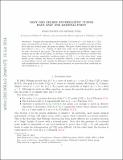| dc.contributor.author | Poonen, Bjorn | |
| dc.contributor.author | Stoll, Michael | |
| dc.date.accessioned | 2015-01-22T19:12:32Z | |
| dc.date.available | 2015-01-22T19:12:32Z | |
| dc.date.issued | 2014-11 | |
| dc.date.submitted | 2014-04 | |
| dc.identifier.issn | 0003-486X | |
| dc.identifier.uri | http://hdl.handle.net/1721.1/93149 | |
| dc.description.abstract | Consider the smooth projective models C of curves y [superscript 2] = f(x) with f(x) ∈Z[x] monic and separable of degree 2g+1. We prove that for g ≥ 3, a positive fraction of these have only one rational point, the point at infinity. We prove a lower bound on this fraction that tends to 1 as g→∞. Finally, we show that C(Q) can be algorithmically computed for such a fraction of the curves. The method can be summarized as follows: using p-adic analysis and an idea of McCallum, we develop a reformulation of Chabauty’s method that shows that certain computable conditions imply #C(Q)=1; on the other hand, using further p-adic analysis, the theory of arithmetic surfaces, a new result on torsion points on hyperelliptic curves, and crucially the Bhargava–Gross theorems on the average number and equidistribution of nonzero 2-Selmer group elements, we prove that these conditions are often satisfied for p=2. | en_US |
| dc.description.sponsorship | John Simon Guggenheim Memorial Foundation | en_US |
| dc.description.sponsorship | National Science Foundation (U.S.) (DMS-1069236) | en_US |
| dc.language.iso | en_US | |
| dc.publisher | Princeton University Press | en_US |
| dc.relation.isversionof | http://dx.doi.org/10.4007/annals.2014.180.3.7 | en_US |
| dc.rights | Creative Commons Attribution-Noncommercial-Share Alike | en_US |
| dc.rights.uri | http://creativecommons.org/licenses/by-nc-sa/4.0/ | en_US |
| dc.source | arXiv | en_US |
| dc.title | Most odd degree hyperelliptic curves have only one rational point | en_US |
| dc.type | Article | en_US |
| dc.identifier.citation | Poonen, Bjorn, and Michael Stoll. “Most Odd Degree Hyperelliptic Curves Have Only One Rational Point.” Ann. Math. (November 1, 2014): 1137–1166. | en_US |
| dc.contributor.department | Massachusetts Institute of Technology. Department of Mathematics | en_US |
| dc.contributor.mitauthor | Poonen, Bjorn | en_US |
| dc.relation.journal | Annals of Mathematics | en_US |
| dc.eprint.version | Author's final manuscript | en_US |
| dc.type.uri | http://purl.org/eprint/type/JournalArticle | en_US |
| eprint.status | http://purl.org/eprint/status/PeerReviewed | en_US |
| dspace.orderedauthors | Poonen, Bjorn; Stoll, Michael | en_US |
| dc.identifier.orcid | https://orcid.org/0000-0002-8593-2792 | |
| mit.license | OPEN_ACCESS_POLICY | en_US |
| mit.metadata.status | Complete | |
